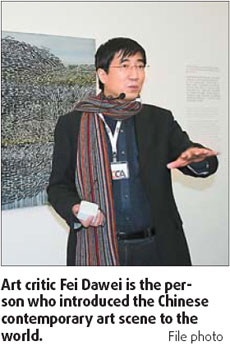Art envoy has mission to spread the word
When Chinese art critic Fei Dawei arrived in France in 1986 carrying more than 1,000 slides of Chinese contemporary art works in his carry bag, he would never have imagined the impact he was about to make. The Western view on China's budding contemporary art scene was about to change forever.
Shanghai-born Fei, a graduate of the Central Academy of Fine Arts in Beijing, gave many speeches and lectures on Chinese contemporary art in Paris, but didn't notice much enthusiasm until he was introduced to Jean-Hubert Martin, then curator of the National Museum of Modern Art at the Center Pompidou.
When Martin heard Fei talk about a flourishing new art scene in the world's most populated nation, the French man became curious. After looking through 200 of Fei's slides, he felt he had found a new continent.
"How many slides do you have?" "1,200," Fei replied. "I want to see all of them," the Pompidou curator said.

Martin was transfixed for almost two days. He carefully examined all the pictures, running through several projector bulbs, and finally decided to come to China with Fei.
"I made a comprehensive list of artists and professors for Martin to visit so he could learn about Chinese contemporary art and art education," says Fei, who holds a jurist position on the United Nations' Literature, Science and Arts Foundation. The French Ministry of Culture awarded Fei in 1999 the Chevalier medal of honor in arts and literature.
In 1987, Fei took Martin around China to see the contemporary art scene. They met critic Gao Minglu, a Harvard University PhD and now a professor with the fine arts department of the University of Pittsburg, and artists such as Wang Guangyi who often adopted the "gray humor" method of producing large-sized portraits, to ridicule.
Later, they went to southern cities such as Nanjing, Hangzhou, Shanghai, Xiamen and Guangzhou. "The schedule was so tight that it was a pity we could not go to Southwest China's Sichuan, where there were many active artists," Fei says.
In May 1989, Martin curated the Magiciens de la Terre exhibition at the Center Pompidou, which brought Chinese art into the international arena for the first time.
The exhibition featured more than 50 Asian, African and Oceanic artists with the works of 50 well-known Western contemporary artists to compare different cultures and to convey the idea that "not everyone was a follower of Western art".
Fei designed the Chinese part of the exhibition, which introduced prominent Chinese artists such as Gu Dexin, whose Plastic Pieces featured prominently.
'85 New Wave Movement
The art scene from 1985 to 1990, later named the '85 New Wave Movement, signaled the birth of Chinese contemporary art and the beginning of China's cultural transformation. It marked a departure from tradition pointing in a new direction.
In February 1989, the China/Avant Garde exhibition at the National Art Museum of China in Beijing pushed the '85 New Wave to its climax, displaying some of the most important works by China's first generation of contemporary artists and attracting "a great many visitors", says Professor Yang Zhiqun of the Nanjing Arts Institute in Jiangsu Province. Yang designed the logo of the Beijing exhibition depicting a traffic sign prohibiting U-turns.
Three portraits of Chairman Mao with pane patterns on the paintings by artist Wang Guangyi from Harbin attracted the most attention.
"The National Art Museum - the highest art palace in China - at that time was basically not willing to admit rebellious contemporary art," critic Zhou Yan, of Ohio State University of the United States, recalls. "Then we talked to the Ministry of Culture and China Federation of Literary and Art Circles."
Art critic Wang Mingxian of the Graduate School of the China Art Academy, one of the major promoters of the groundbreaking exhibition, says sponsorship at that time was very hard to find. The National Art Museum only agreed to host the exhibition when the artists found the financial backing of businessman Song Wei and the support of Feng Jicai, a well-known writer who published a literature journal based in Tianjin.
"Most artists at that time were poor. Their art works were not for sale. Prices were very low if someone offered to buy," Wang says.
Before 1985, art was still closely tied to politics in China, but with more arts graduates going abroad, artists started to "reinvent their own culture, breaking free from decades of socialist realism to begin a process of intense experimentation," Fei says.
(China Daily 12/18/2007 page18)














